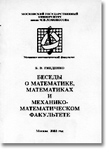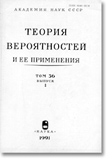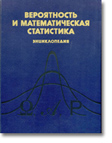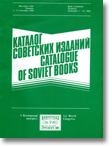|
Probability background
Mathematical background of the Actuarial Science is Theory of
Probability, Mathematical Statistics and Theory of Random
Processes.
From the mathematical point of view, the Risk Theory, being
highly appreciated by the insurance theory and practice, is no
more than a subsection of Theory of Probability called "boundary
problem of the random processes". The latter problem appears in
diverse applications outside Economics.


The balance between the fundamental and applied knowledge was
discussed by many generations. The Russian-speaking persons bear
in mind the famous fable of I.A. Krylov written back in 19th
century; the balance is illustrated
in an inerasable manner:



The Russian (and the Soviet, as its part) probability school was
created by P.L. Tchebyschev, A.A.
Markov, A.M. Liapounov, S.N. Bernstein, A.N. Kolmogorov,
B.V. Gnedenko, A.Ya. Khinchine, Yu.V. Linnik, L.N.
Bolshev, A.V. Skorokhod, V.S. Koroljuk,
and - in general - by the Moscow, Leningrad, Kiev, Novosibirsk,
Vilnius, Tbilisi, Tashkent schools which collaborated a
lot. It contributed considerably to
the understanding by humankind of the Event of Randomness.
Telling about his own career, Harald Cramér, one of the
founders of the Risk Theory and modern
Actuarial Science, wrote a paper
 "Half a century with
Probability theory: some personal recollections" (The
Annals of Probability, 1976, Vol. 4,
No. 4, 509-546;
the Russian
translation of this paper was
published in 1979), where the name of Kolmogorov was mentioned
42 times, of Khinchine - 20 times, and
of Gnedenko - 6 times.
"Half a century with
Probability theory: some personal recollections" (The
Annals of Probability, 1976, Vol. 4,
No. 4, 509-546;
the Russian
translation of this paper was
published in 1979), where the name of Kolmogorov was mentioned
42 times, of Khinchine - 20 times, and
of Gnedenko - 6 times.
 In particular, Cramér (on
p. 517, in Section 3.4. "The new
Russian school") wrote: In particular, Cramér (on
p. 517, in Section 3.4. "The new
Russian school") wrote:
"All through the latter part of the 1920's, it was clear that
a strong new activity in mathematical
probability was taking place in the Soviet Union. In a
remarkable paper of 1927, S.N. Bernstein
discussed the extension of the central
limit theorem to sums of random variables which are not required
to be independent. He introduced an
important method of dealing with such cases, to
which I shall return later.
But the main Russian works of this period were written by two
quite young mathematicians, A.Ya.
Khintchine and A.N. Kolmogorov, who were to be leaders in
the coming development of the field. In a joint paper of
1925 they proved the famous "three
series theorem", giving necessary and sufficient conditions for
the convergence of a series, the terms of which are
independent random variables. The
probability that such a series is convergent can only be equal
to zero or one, which is
 a particular case of the so
called "zero-one law," discovered at
the same time...", a particular case of the so
called "zero-one law," discovered at
the same time...",
an further (on p. 535, in
Section 6.4. "Moscow, 1955"):
"In May 1955 the University of Moscow celebrated its
bicentennial, and I was invited to
attend, representing the Stockholm University. It was a great
event, and it gave me an opportunity
to make the personal acquaintance of the Soviet
mathematicians, whose work had meant so much for the
advancement of probability theory.
Unfortunately,
Khintchine was ill - he died shortly afterwards - but I
met Kolmogorov, who gave the impression of being a great
scientific personality, and I had some
interesting conversations with him. I was also
happy to meet other members of their probabilistic group.
There was Dynkin, who was beginning
his great work on Markov processes, Gnedenko who in
collaboration with Kolmogorov had
written the book on
 limit problems referred to above,
Linnik who was beginning his work on large deviations so
closely connected with my own work of
1937, Yaglom and Rozanov who were to do outstanding work on
stationary processes, and many others. They formed a
group of wonderful scientific activity,
and were preparing to start their new Journal of
Probability Theory and its Applications, which soon
acquired an internationally leading
position in the field. limit problems referred to above,
Linnik who was beginning his work on large deviations so
closely connected with my own work of
1937, Yaglom and Rozanov who were to do outstanding work on
stationary processes, and many others. They formed a
group of wonderful scientific activity,
and were preparing to start their new Journal of
Probability Theory and its Applications, which soon
acquired an internationally leading
position in the field.
In connection with this Bicentennial there was also a
mathematical conference, and I gave a
lecture on my recent work on the ruin problem. Later in the same
year, Kolmogorov spent some time in Stockholm as the
guest of our university, and gave a
series of lectures on limit theorems in probability to our group".
Though many of the above mentioned colleagues have passed away,
their works are
 available for those
who wish
to study the Probability Theory. available for those
who wish
to study the Probability Theory.
The journal "Theory of Probability and its Applications" founded
by Kolmogorov is published quarterly
since 1956 and until now. Many prominent works have
appeared in this journal; highly professional papers are
published there nowadays.
The highly professional Encyclopedia "Probability and
Mathematical Statistics" has appeared
in 1999. It fixes the current state of arts in this field.
The Russian library of professional monographs covering many
aspects of the Probability Science is
very large. It comprises both original monographs and
translations. In 1996 the First World Congress of the
Bernoulli Society was held in Tashkent
(Uzbekistan). Useful may be the
catalogue which
makes a rather complete list
 of the probability publications, mainly from the
publishers "Mir", "Nauka", "Finansy i
Statistika".
of the probability publications, mainly from the
publishers "Mir", "Nauka", "Finansy i
Statistika".
|


